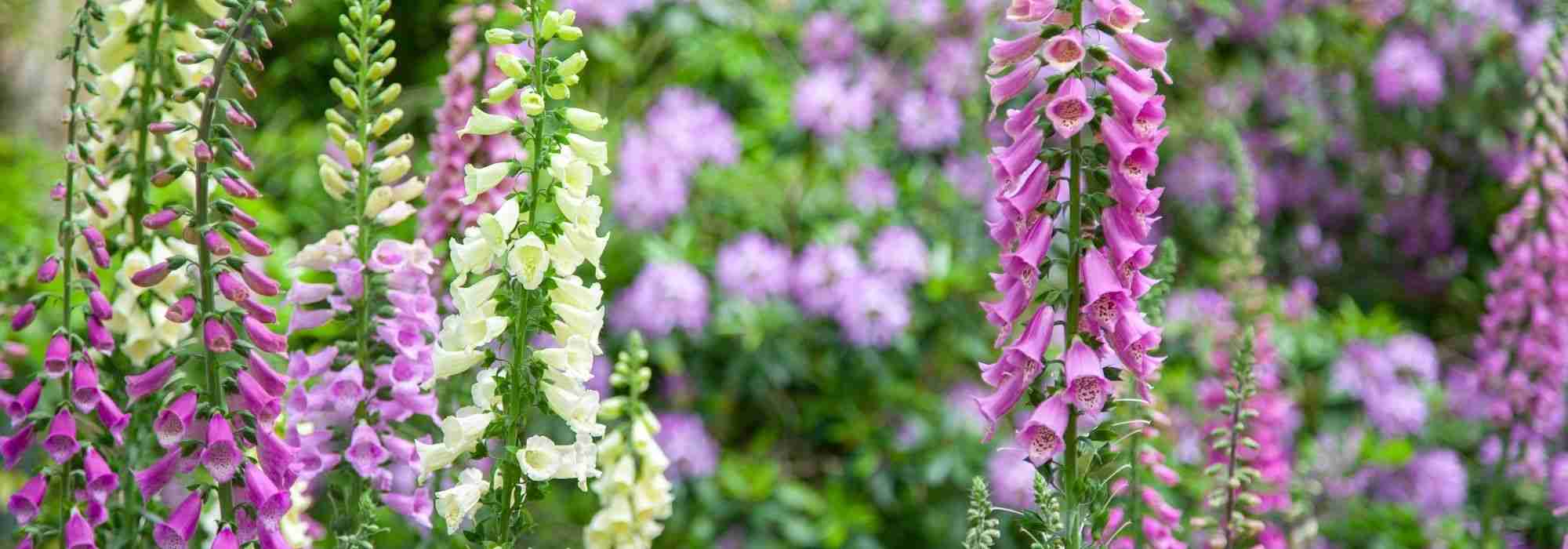
Choosing a foxglove
Our buying guide
Contents
Also known as Lady’s Glove or Shepherd’s Glove, Foxglove is sensational with its brightly coloured flowers inserted on long spikes. Known for its toxicity, there are about twenty species. Cross-breeding between Digitalis and Isoplexis has even led to the creation of Digiplexis. A plant for partial shade with summer flowering, Foxgloves are often grown as biennials, as their life cycle generally spans two years. The rosette of leaves develops in the first year, then it flowers in the second year, and finally dies after flowering. Some exceptions, such as Digitalis mertonensis and Digitalis ‘Glory of Roundway’, are part of the perennial plants and live for several years. Here are our tips for choosing a foxglove from the many varieties based on different criteria.
Also, discover our complete guide Foxgloves: sowing, planting, and maintenance
According to height
Ideal for cottage gardens or priest gardens, foxgloves are tall, upright young plants that bring rhythm and verticality to borders. Foxgloves can be classified into three height categories:
Small – between 50 cm and 1 m tall
It is worth noting that a large majority of foxgloves do not exceed 1 metre in height. For example, the small hybrid foxglove ‘Goldcrest’ does not exceed 50 cm in height, while Digitalis parviflora and grandiflora reach heights of 70 and 80 cm respectively, and the white foxglove ‘Alba’ reaches 1 metre at maturity.
Medium – between 1 m and 1.30 m tall
Next, species and varieties with heights ranging from 1 metre to 1.30 metres are rarer. With their upright and not overly wide habit, they are ideal for borders. For instance, Digitalis purpurea ‘Pam’s Choice’, ‘Camelot Rose’, and Digitalis ferruginea ‘Gigantea’ have a height of about 1.20 metres and do not exceed 40 to 50 cm in spread.
Large – minimum 1.40 m tall
Finally, Digitalis mertonensis ‘Summer King’ and the typical species of the purple foxglove are the tallest, reaching heights of 1.40 to 1.50 m, and even up to two metres!

Digitalis obscura grandiflora ‘Goldcrest’, Digitalis ferruginea ‘Gigantea’ (photo Wikipedia) and Digitalis purpurea (photo NevitDilmen)
Read also
Foxgloves: sowing, planting and careAccording to the colour of the flowers
Impressive with their tall, upright flower spikes, foxgloves offer us magnificent flowering in white, yellow, orange, pink, purple, and even brown. The shades are highly varied. Elegant and naturally styled, they appear so simple, yet upon closer inspection, one can observe small details within the flowers that add to their charm: some varieties are veined, while others are speckled with irregular dots or patches. Here’s an overview of the different colours available:
White-flowered Foxgloves
Digitalis purpurea ‘Alba’ and Digitalis purpurea ‘Snow Thimble’ produce flower spikes up to one metre tall bearing large white flowers measuring 5 cm.
Yellow and orange-flowered Foxgloves
- Digitalis grandiflora and Digitalis lutea bear pale yellow flowers approximately 3-4 cm in size.
- The flowers of Digitalis ciliata are also yellow, but brighter and speckled with beige.
- The hybrid foxglove ‘Goldcrest’ and the variety ‘Spice Island’ offer peach-yellow blooms: rosy and coppery for the former and paler with brown veining for the latter.
Pink and purple-flowered Foxgloves
- In soft pink shades, we can mention the very romantic cultivars ‘Suttons Apricot’ and ‘Glory of Roundway’, delicately speckled with darker pink.
- Digitalis mertonensis and the variety ‘Summer King’ of the same species feature flowers of a more intense pink with a spotted centre.
- The purple foxglove ‘Camelot Rose’ and Digiplexis ‘Berry Canary’ are bright pink, with a throat speckled in burgundy.
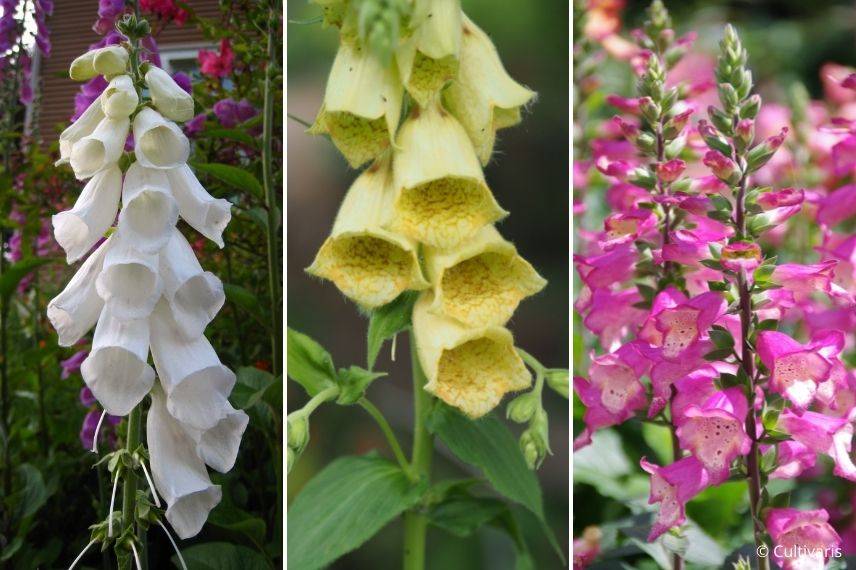
Digitalis purpurea ‘Alba’ (photo Ciar), Digitalis grandiflora and Digitalis x valinii ‘Berry Canary’
Brown-flowered Foxgloves
Digitalis parviflora and Digitalis ferruginea ‘Gigantea’ offer brown and golden blooms.
Two-tone Foxgloves
- The bells of Digitalis lanata bloom in cream. The very light lower lip contrasts with the marbled brown, almost purple throat.
- Digitalis purpurea ‘Pam’s Choice’ and ‘Pam’s Split’ produce flowers with a white corolla and a throat heavily speckled with burgundy. These two cultivars are very similar.
Multicoloured Foxgloves
- Very colourful and warm, Digiplexis ‘Illumination Flame’ is flamboyant with its red, fuchsia pink, orange, and yellow flowers.
- In Digitalis purpurea and ‘Monstrosa’, the flowers can sometimes be pink, purple, or white.
- Finally, the tricoloured flowers of Digitalis lanata ‘Cafe Creme’ are tinged with grey, bronze, and yellow.
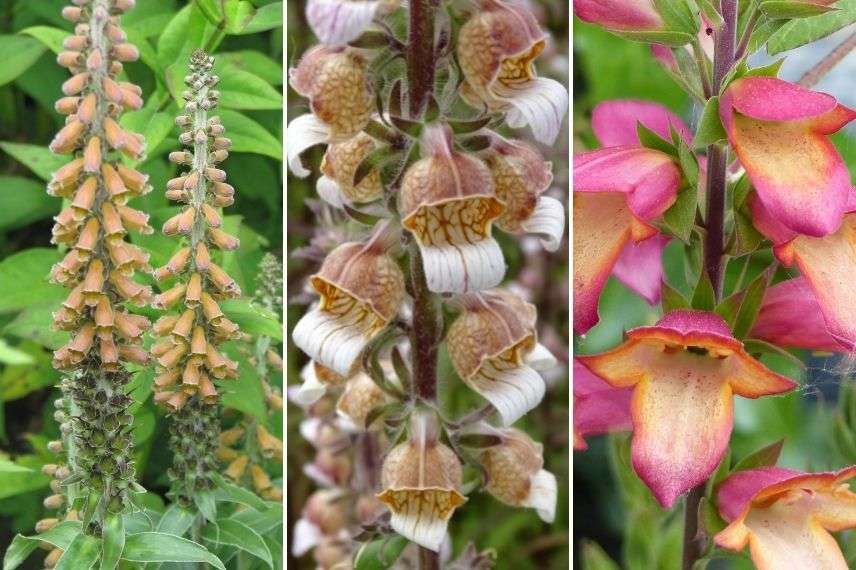 Digitalis parviflora (photo Peganum), Digitalis lanata and Digitalis x valinii ‘Illumination Flame’
Digitalis parviflora (photo Peganum), Digitalis lanata and Digitalis x valinii ‘Illumination Flame’
Discover other Digitalis - Foxglove
View all →Available in 0 sizes
Available in 3 sizes
Available in 2 sizes
Available in 1 sizes
Available in 1 sizes
Available in 2 sizes
Available in 2 sizes
Available in 0 sizes
Available in 0 sizes
Available in 1 sizes
According to the shape of the flowers
The flowers of Foxglove have the unique characteristic of appearing all on the same side of their stem. The lower flowers always bloom first, followed progressively by those above. The corolla is tubular in shape, more or less wide, long and flared, or bell-shaped and globular.
- For example, Digitalis lutea, the variety ‘Glory of Roundway’ and Digitalis purpurea ‘Snow Thimble’ have flowers with thin and narrow tubes.
- Bearing flowers with widely open tubes, the Purple Foxglove ‘Pam’s Split’ facilitates access for pollinating insects with its split petals. The lower lip of the flowers of Digiplexis ‘Illumination Flame’ also serves as a landing pad, and the corollas of the ‘Summer King’ Foxglove are greatly flared.
- In the category of well-rounded globular flowers, we can mention Digitalis ferruginea ‘Gigantea’ and Digitalis lanata.
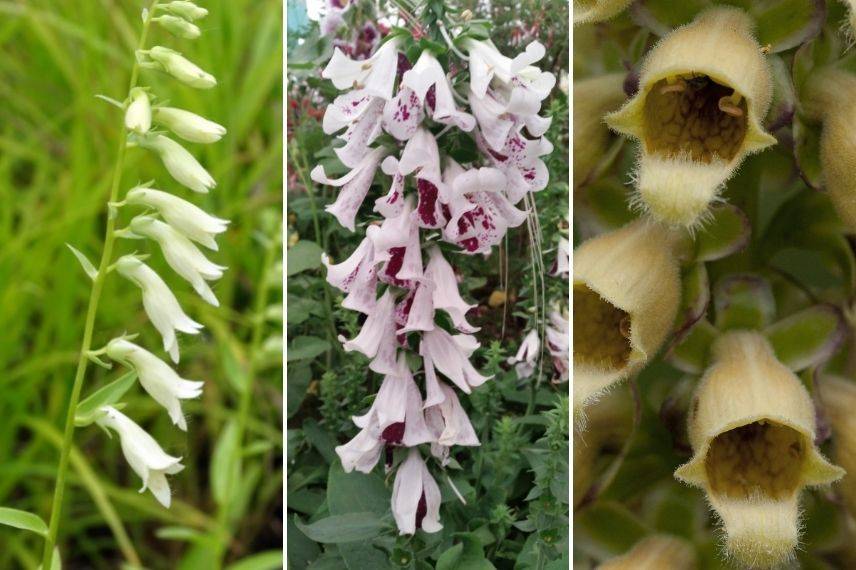
Digitalis lutea, Digitalis purpurea ‘Pam’s Split’ and Digitalis ferruginea ‘Gigantea’
- Finally, there is one exception that is a true mystery of nature: the Purple Foxglove ‘Monstrosa’. It bears numerous tubular flowers in clusters along its flowering spikes, and curiously, it features at the end of each stem a huge, well-opened cup-shaped flower with serrated petals!
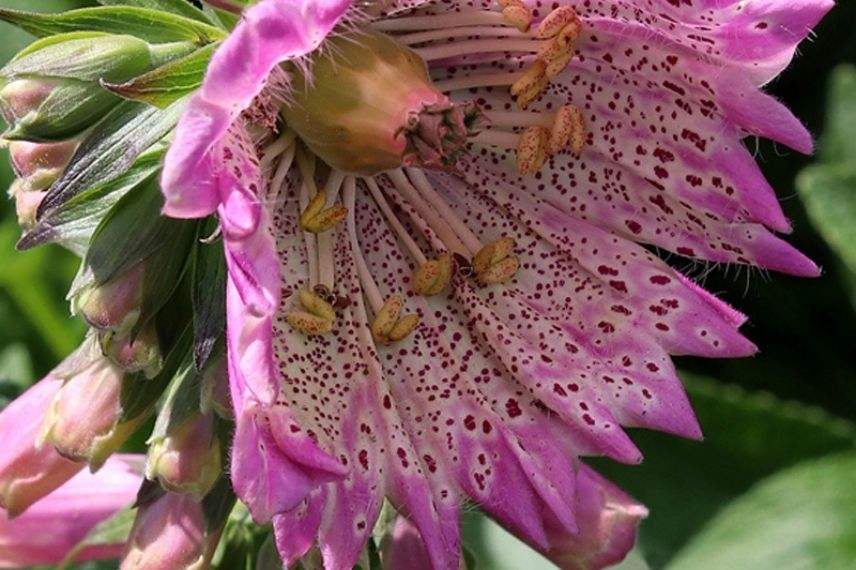
Digitalis purpurea ‘Monstrosa’
According to the flowering period
Digitalis generally flowers in June/July. Some are earlier and already show their flowers in May, such as Digitalis purpurea ‘Camelot Rose’, ‘Pam’s Choice’ and ‘Alba’. For the varieties ‘Goldcrest’, ‘Spice Island’ and Digiplexis ‘Berry Canary’, ‘Illumination Flame’ and ‘Illumination Raspberry’, flowering can even extend until October.
According to the exposure
Most Digitalis are semi-shade plants, such as Digitalis grandiflora and Digitalis lutea. Some species and varieties can be grown in sunny but not scorching exposure, for example Digitalis mertonensis and Digiplexis ‘Illumination Raspberry’. If you are in a region south of the Loire, we recommend planting them in a location sheltered from the sun during the hottest hours of the day.
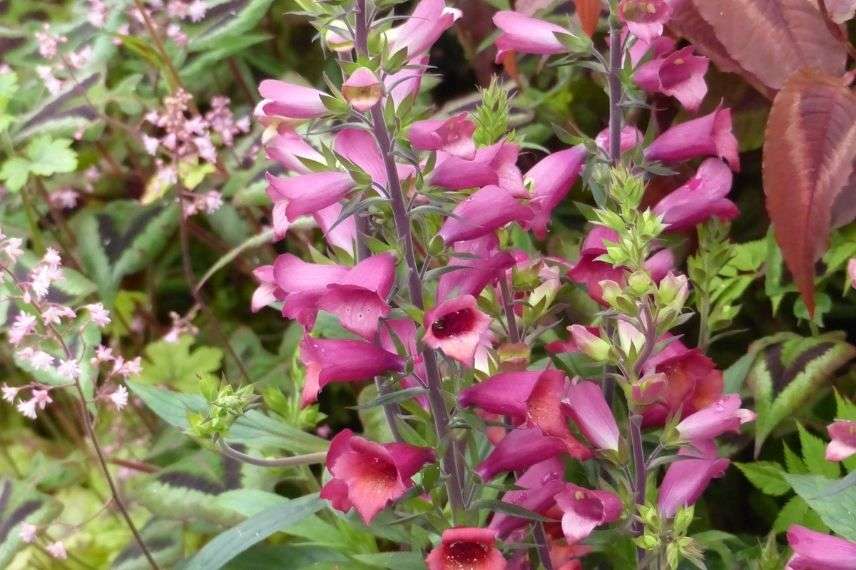
Digitalis x valinii ‘Illumination Raspberry’
According to pH and soil type
All neutral soils are suitable for Foxgloves, but they prefer acidic soils. Some can grow in dry, chalky soil: the woolly Foxgloves, Digitalis parviflora, lutea, grandiflora, obscura and Digitalis ferruginea ‘Gigantea’. They thrive in light, cool soil in summer that is rich in organic matter. To avoid promoting the appearance of fungal diseases, planting in heavy, clayey soil should be avoided.
According to hardiness
In general, foxgloves have good hardiness and can withstand temperatures down to -10/-15°C. The hardiest varieties can endure temperatures below -15°C: Digitalis ‘Goldcrest’, ‘Glory of Roundway’, Digitalis parviflora and grandiflora, as well as the woolly foxglove.
According to the use
- To flower a terrace, it is possible to grow Foxglove in a large pot or container. The small hybrid ‘Goldcrest’ and Digiplexis ‘Berry Canary’ have a perfectly suitable size, reaching 50 to 70 cm in height and 30 to 50 cm in width.
- In borders, the larger Foxgloves are placed at the back, such as Digitalis purpurea ‘Pam’s Choice’, ‘Camelot Rose’, and ‘Monstrosa’. Smaller varieties, reaching about 70 to 80 cm in height, such as Digitalis ‘Spice Island’, ‘Glory of Roundway’, and Digitalis parviflora can be placed further forward. These create beautiful mixed borders in a natural style, surrounded by shorter plants to highlight the tall flower spikes.
- To flower a bank or dry rockery, install heat and drought-resistant Foxgloves, such as Digitalis lutea and grandiflora.

According to the life cycle: biennial or perennial
When talking about Foxglove, one often thinks of ‘biennial plant’, having a life cycle of two years, such as Digitalis lanata. However, be aware that there are also Foxgloves considered as perennial plants, despite their short lifespan (2 to 4 years). Among them, we can mention: Digitalis mertonensis, Digitalis lutea, Digitalis ‘Glory of Roundway’, Digitalis parviflora, Digitalis grandiflora, Digitalis ferruginea, Digitalis obscura and Digitalis obscura grandiflora ‘Goldcrest’. The Digitalis purpurea is biennial, but can also be perennial if the growing conditions are optimal: a sunny or slightly shaded position and acidic, well-drained soil.
To extend their lifespan by 2 or 3 years, it is essential to cut back the flower spikes as soon as they have faded. This will prevent seed production, which exhausts the plant, and encourage the emergence of new rosettes.
Foxgloves self-seed spontaneously and abundantly if planted in good conditions; however, the new plants may not be similar to the parent plant. You can also leave a few flowers on the plant if you wish to collect the seeds and sow them in buckets.
Feel free to discover Virginia’s favourite perennial Foxgloves!
- Subscribe!
- Contents
































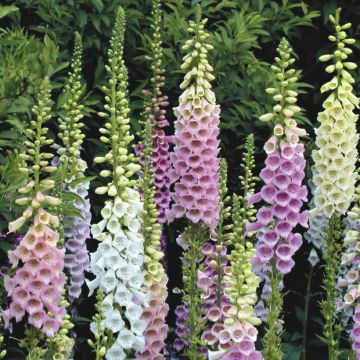
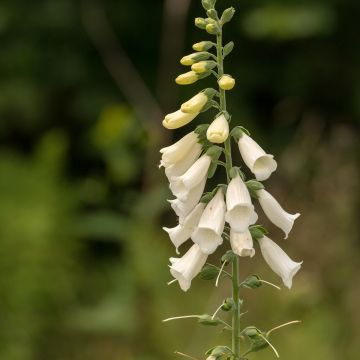
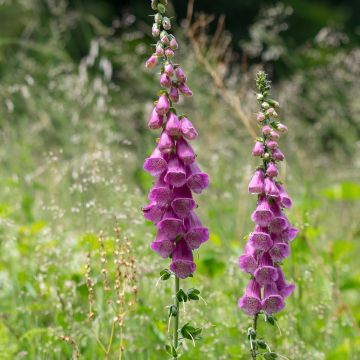
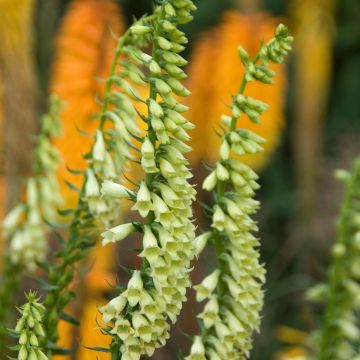

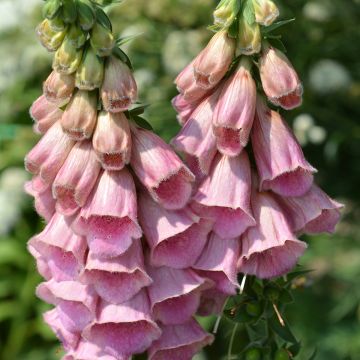

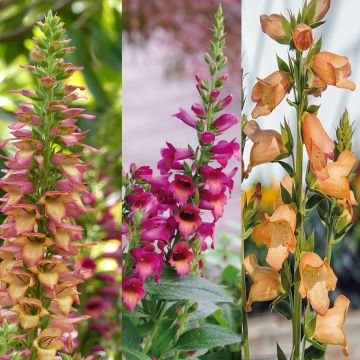


Comments